|
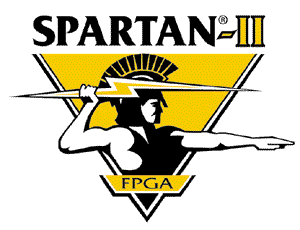
The Spartan™ series of FPGAs (Spartan-II, Spartan-XL, and Spartan
families) provides an effective ASIC production solution for many
gate array designs. Derived from the successful Xilinx XC4000 and
Virtex architectures and supporting up to 200,000 system gates, the
Spartan series combines low ASIC production pricing with ASIC
features such as on-chip RAM, low power, high performance and a
robust selection of silicon-verified cores. The Spartan series is
the first FPGA that meets all of the key cost, feature and
performance criteria to realistically replace mask gate arrays in
production. The Spartan series simply provides FPGA flexibility at
ASIC prices!
ASIC Features
- On-chip SelectRAM dual port synchronous memory, placed at any
location
- High performance - 80 MHz to 200 MHz system speeds
- Extensive verified portfolio of cores with AllianceCORE and
LogiCORE products
- Built-in IEEE 1149.1 Boundary Scan support
- Low-power design permits Spartan devices to use inexpensive
plastic packages
- Comprehensive Verilog and VHDL software support featuring
Xilinx partners
ASIC Pricing
Xilinx can offer ASIC production pricing because the Spartan
series has substantially reduced the die size and manufacturing
costs. Cost targets were realized by using an advanced fabrication
process and streamlining the FPGA features. Spartan series die has
been decreased to limits imposed by the I/O pads and, as a result,
has reached die size parity with many gate arrays. The Spartan FPGA
and a mask ASIC with the same number of pins are equivalent in both
size and cost. Spartan FPGAs offer volume production prices as low
as $2.49 for Spartan-XL devices (5,000 system gates) and less than
$10.00 for 100,000 gate Spartan-II devices.
Major ASIC Vendors Exit the Gate Array Business
The mask ASIC is actually penalized when migrating to the
advanced deep sub-micron technologies at 0.35 mm and beyond. The penalty occurs because the
transistors in deep sub-micron devices have shrunk much faster than
metal lines. The result is that interconnect delay now dominates
gate delay. Minimizing interconnect delay requires adding metal mask
layers to create more routing resources. Each photo mask for the
0.35-mm process costs the ASIC supplier
from $12,000-$15,000, as well as extending the prototype fab time.
Since most ASICs today are fabricated with four or five custom metal
layers, a $60,000-$75,000 cost for photo masks for each different
customer design easily results in more than $100,000 in
Non-Recurring Engineering (NRE) charges to the customer! The
Spartan FPGA does not incur the same cost penalties of ASICs because
each photo mask is created only once over the lifetime of the
programmable device and serves hundreds of different customers.
A deep sub-micron gate array loses much of its value when NREs are
increased to more than $100,000 and prototype time is extended. This
is a primary reason that gate array vendors such as LSI Logic and
Motorola have exited the gate array business to focus on the complex
Standard Cell market.
Total Cost Management Program
Spartan FPGAs also apply an aggressive Total Cost Management
Program to hold product costs low. For example, the Xilinx Spartan
series has
- Limited the number of family members
- Supported a very focused offering of inexpensive plastic
packages
- Optimized the test flow to reduce back end costs
Qualifying Gate Array Design for a Good FPGA Fit
The graph below plots the Spartan series parts according to
system gates and number of I/O. As indicated, Spartan FPGAs are most
cost-competitive in the low-density/high I/O (lower right) segment.
The graph may be used as a reliable indicator to determine where the
Spartan FPGAs can be most competitive with the ASIC in mass
production. In short, when the Spartan FPGAs have the same number of
I/Os as the ASIC and meet the density needs of your design, the FPGA
will clearly be a better choice. By choosing Spartan devices you
receive the time-to-production and reprogrammability advantages of
FPGAs at ASIC prices. For higher densities and I/O counts, consider
the Xilinx Virtex series.
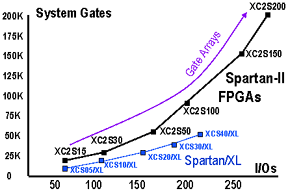
Immediate Production
A fast ramp to full production is a primary advantage of these
ASIC Replacement FPGAs. Spartan series deliveries are off the shelf
from the Xilinx factory or from the inventory of our distribution
partners, while typical ASIC lead times run from 8-16 weeks.
Immediate Spartan FPGA production enables fast stocking of your
sales channels and the rapid penetration of your customer base.
Spartan FPGAs help you avoid the delays resulting from the long ASIC
lead times that may substantially decrease revenues and profits
throughout the life of the product. A well-known McKinsey study
found that a six month delay costs one third of the profits over the
lifetime of the product.
No FPGA Conversions for Spartan Series Users
The ASIC prices of Spartan series devices eliminate the need for
low-density FPGA conversions to mask gate arrays. The Spartan FPGA
user speeds time-to-production, minimizes development/NRE costs, and
avoids unnecessary re-design risks by foregoing an FPGA-to-ASIC
redesign.
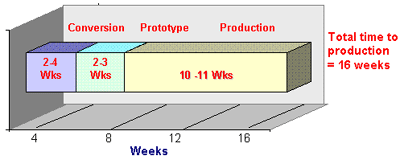
Turnaround time:
- FPGA to ASIC conversions take a minimum of four months to
production. The typical breakdown is the following:
- Conversion time - 3 weeks average
- Prototype time - 3 weeks best case
- ASIC full production lead time - 8-16 weeks
- Total conversion time-to-production = 4 months or
more!
Costs:
- NRE/conversion fees - ~$10,000-$30,000
- Cost of your internal conversion engineering efforts -
~$20,000
- Simulate and verify redesign
- Qualify prototypes
- Transfer into production
|
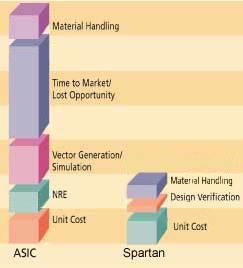 | Conversion Redesign
Risks:
- Converting FPGA features such as on-chip RAM, scan, reset,
etc.
- Netlist changes adding new buffers and new I/O drive
capabilities
- Change of timing to new ASIC architecture
- Porting of FPGA cores - complex licensing issues moving to new
platform
The New FPGA Paradigm: No Costly FPGA
Conversion Needed
- Spartan FPGAs are intended for fast development and
cost-effective production
- Advantages of the FPGA in mass production:
- No conversion engineering effort
- No NRE or conversion fees
- Cost reduction path through future generations
- Immediate volume production!
Converging HDL Design Methodologies
Historically, programmable logic development methodology has
lagged the ASIC industry by at least five years. This gap began to
narrow in the early 1990s with the adoption of VHDL by a few PLD
designers for more complex designs. As FPGAs continued to grow in
density beyond the 20,000 gate level, the schematic design approach
began to falter. It became obvious that implementation of VHDL
support, and later Verilog support, would be necessary for the
programmable vendors to continue offering greater device density and
to provide the ASIC designer with a familiar design environment.
ASIC and FPGA Converging Design Approach
Today, the design methodologies have converged to the extent both
ASIC and Xilinx FPGA design flows support behavioral simulation,
extensive use of cores, RTL synthesis, timing and functional
simulation, static timing analysis, floorplanning, etc. Xilinx has
added other widely used ASIC-like tools such as minimum delay timing
reports, more comprehensive static timing, team approach modular
design and much more.
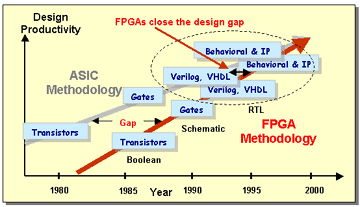
Xilinx HDL Training for Programmable Logic
Xilinx FAEs are available to work with ASIC designers to ease the
learning curve of programmable designs. In addition, Xilinx offers
formal instruction in HDL design through Xilinx
training courses.
Comparing ASIC and Spartan FPGA HDL Design Flows
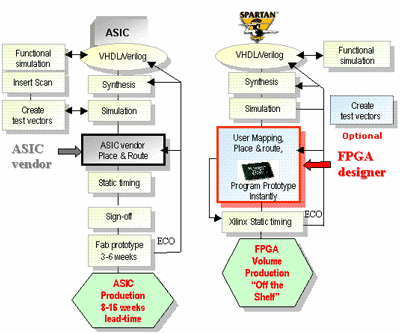
|
Spartan Family Choices
|
Spartan-II

|
Spartan-XL

|
Spartan

|
Gates plus
System-Level Features
|
Lowest Cost,
Low Power |
5V Supply |
| Max System Gates |
15,000 to 200,000 |
5,000 to 40,000 |
| Logic Gates |
6,000 to 100,000 |
2,000 to 13,000 |
| Block RAM |
16K to 56K bits |
N/A |
| I/O Perf. |
200 MHz + 4 DLLs |
100 MHz |
80 MHz |
| Max I/O |
86 to 284 |
77 to 224 |
77 to 205 |
| Supply Voltage |
2.5V |
3.3V |
5V |
| I/O Standards |
16 |
4 |
2 |
Spartan-II
Family Product Overview
Spartan-XL
Family Product Overview
Spartan
Family Product Overview
|


